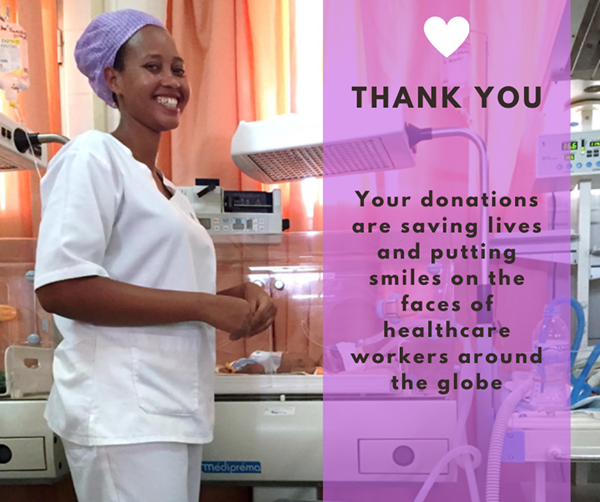
Rotarian Marg Wagner introduced Dr. Ruth Mathieson, a fellow Rotarian and friend Marg has known and worked with for many years on a number of Rotary Committees, one being International Service.
Dr. Mathieson supposedly retired from her medical practice where she cared for patients from birth to death and everything in between, but every winter Dr. Ruth would volunteer for months at a time at an AIDS clinic in Kenya as well as volunteering at a mission hospital in Nigeria in the surgical department. If anyone knows the real story of medical conditions in developing countries, it is Dr. Ruth Mathieson. She is introducing the Club to Safe Anaesthesia Worldwide, also known as SAWW, an organization that provides equipment, training and research to support poorly resourced hospitals to provide improved and safe delivery of anaesthesia. SAWW was founded in 2011 at the village pub in Marden, Kent, England and became a registered U.K. charity in 2012.
Five billion people are without anaesthesia and surgical care worldwide, estimated as two-thirds of the world's population. This contributes to seventeen million deaths per year. Anaesthesia is needed for emergency C-Sections, the most common major operation in Africa as well as surgical repair of birth defects such as cleft lip and palate and surgical repair of NOMA, a facial gangrene that affects poor children in Africa. Serious burns, common due to open cooking fires in Africa also require surgical repair and treatment as well as traumas and injuries from road traffic accidents. Many patients have to travel long distances to receive medical care when they are seriously ill and they often arrive in critical condition. Lack of infrastructure, poor roads and inadequate transport make it difficult for patients and medical supplies to reach hospitals. Dr. Ruth saw this first hand when she worked at Matangwe Mission Hospital. They didn't have the luxury of electricity until 2014 and a lot of medical work was done in next to dark conditions with just a paraffin lamp for light. Nigeria power was nicknamed NEPA which the nuns said meant "no electrical power any time". Medical oxygen is expensive and difficult to transport, electrical supplies are unreliable, hospital equipment is old and not fully functional, medical supplies are extremely limited and hospital wards and clinics are overcrowded. On top of these challenges, there are too few doctors and trained healthcare staff and a lack of technicians and engineers so it is very difficult to service and repair equipment. SAWW works closely with local hospitals to ensure what is supplied is precisely what is needed.
Backtrack to when Dr. Ruth was at medical school years ago in a small class at St. Andrews in England. The medical students became close after six years of school together. Dr. Ruth graduated in 1964. One of her classmates, a fellow by the name of Roger Eltringham, was responsible for coordination of anaesthesia courses and upon his travels after graduation, was shocked to find rusty old equipment being used and donated equipment remaining useless for lack of electricity and biomedical engineers. It took years, but Roger worked to invent and develop a portable anaesthesia machine, spending hundreds of unpaid hours developing machines. The GLOSTAVENT anaethesia machine was the end product and Dr. Ruth first heard about the machine at a 50th class reunion in 2014 when Roger brought a unit with him to a lecture. Dr. Ruth was smitten with this machine and started work almost immediately to raise money for three machines needed in Kagera, a region of Tanzania, an area with 2.7 million people, 90% who are agricultural workers with limited access to health services. This region has a high rate of maternal deaths due to haemorrhages, infections, obstructive labour and hypertension disorders. Three (3) rural hospitals did not have a fully functional anaesthesia machine and had no funds available to purchase.
The cost of one portable kit is £4550 or $8,000 Canadian and includes a portable anaesthesia machine, an oxygen concentrator, and a pulse oximeter (as pictured above). The kit will work anywhere, needs no electricity, will function without oxygen, is inexpensive to run, is simple to use and easy to maintain. This kit is comparable to a state of art machine at BGH that would cost $130,000. Dr. Ruth got to work and submitted a district grant and approached other Rotary Clubs for donations, including the Rotary Club of Belleville. Dr. Ruth was pleased to announce that three of these kits, made by Diamedica a small company in England, are on their way to Kagera. Upon arrival they will be taken to three hospitals in order to train staff in their use and maintenance. It is hard to put a figure on the number of lives that have been saved by Roger's invention. Dr. Ruth estimates there must be millions of patients who otherwise would not receive anaesthesic for surgery in remote areas. Roger himself single handedly raised £280,000. Dr. Mathieson thanked the Rotary Club of Belleville for their generous contribution of $4,200 towards this project.

Birgit Wartenberg thanked Dr. Ruth for her presentation and congratulated her on the successful grant monies received for this project. Dr. Ruth has inspired many people and has worked on many successful projects. Often we forget what conditions are like in other parts of the world and Dr. Ruth focuses on this and reminds us how much work there is to do.
